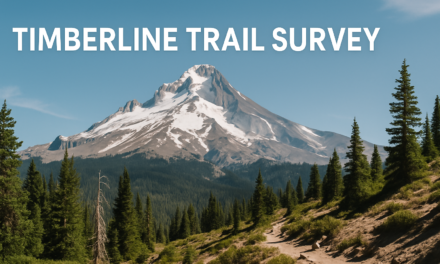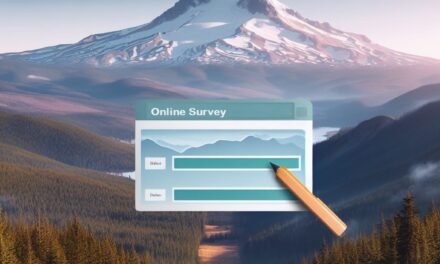This is the second part of the 2024 Timberline Trail Survey raw results. To see the first set of results please see here. This continues the raw data sets from the 2024 survey. Again the entire survey will be presented in three parts.
How would you rate the difficulty of traverses?
The 2024 survey expanded the list of traverses compared to previous years, now including six major traverse sections. The results show some interesting patterns in how hikers perceived the difficulty of these challenging sections.
Traverse Difficulty Rankings:
- Eliot: 28% Easy, 46% Moderate, 26% Difficult
- Gnarl Ridge: 44% Easy, 46% Moderate, 11% Difficult
- Newton: 47% Easy, 48% Moderate, 5% Difficult
- White: 47% Easy, 43% Moderate, 10% Difficult
- Sandy: 50% Easy, 44% Moderate, 5% Difficult
- Zigzag: 70% Easy, 28% Moderate, 2% Difficult
No surprise that the Eliot was ranked as the most challenging traverse, with 26% of hikers rating it as difficult – more than double any other traverse. This notorious section continues to be the crux of the entire Timberline Trail, requiring careful route finding and often scrambling skills.
The Zigzag traverse was overwhelmingly considered the easiest, with 70% rating it as easy. The Sandy, Newton, and White traverses fell into a similar middle ground, with roughly half of hikers finding them easy and the other half rating them as moderate difficulty.
Interestingly, the traverse difficulty ratings suggest that most hikers found the technical sections manageable, with only the Eliot presenting significant challenges to a substantial portion of trail users.
Which of the following was an issue for you?
This broad category explored typical hiking challenges that weren’t medical-related, covering everything from weather conditions to wildlife encounters and group dynamics. The 2024 hiking season appears to have been quite favorable overall, with the vast majority of hikers reporting minimal issues.
Top Issues Reported:
- Mosquitoes: 36% had some level of issue (27% mild, 8% moderate, 1% major)
- Navigation: 24% had some level of issue (21% mild, 2% moderate, 1% major)
- Smoke: 22% had some level of issue (18% mild, 5% moderate)
- Rain: 17% had some level of issue (14% mild, 1% moderate, 3% major)
- Wind: 17% had some level of issue (13% mild, 1% moderate, 2% major)
Mosquitoes topped the list of issues in 2024, with over one-third of hikers reporting at least mild problems with these persistent insects. Navigation came in second, which is somewhat concerning given the importance of staying on route in this challenging terrain.
The good news is that serious wildlife encounters remained extremely rare, with 100% of hikers reporting no issues with bears or mountain lions. Group dynamics and interactions with other hikers were also rarely problematic.
Weather-related issues were relatively modest, suggesting 2024 provided generally favorable hiking conditions. However, when weather problems did occur, they were sometimes severe, with a few hikers reporting major issues with both rain and wind.
What kind of shoes did you wear?
The trend toward lighter footwear in the hiking community continues to accelerate. The 2024 results show an even more dramatic shift away from traditional hiking boots.
Footwear Breakdown:
- Trail runners: 72%
- Hiking boots: 21%
- Hiking shoes: 7%
- Other: 1%
Trail runners have become the dominant choice, with nearly three-quarters of Timberline Trail hikers choosing this lightweight option. This represents a significant increase from previous years and reflects the broader trend in the hiking community toward minimalist footwear.
Traditional hiking boots now represent only about one-fifth of hikers’ choices, continuing their decline as the go-to option for multi-day backpacking. The small percentage choosing hiking shoes or other options suggests that most hikers have settled into the trail runner versus boot debate, with trail runners clearly winning.
This shift likely reflects improved trail runner durability, better understanding of foot care techniques, and the weight savings benefits for long-distance hiking.
Did you take trekking poles?
Trekking poles remain nearly universal among Timberline Trail hikers, and their adoption has reached even higher levels in 2024.
Trekking Pole Usage:
- Two poles: 91%
- No poles: 5%
- One pole: 3%
An overwhelming 91% of hikers brought two trekking poles, reflecting their importance for stability and support on this challenging trail. This represents a slight increase from previous years, suggesting that word continues to spread about their benefits.
The small percentage hiking with a single pole (3%) might represent hikers who need one hand free for other purposes, such as managing a dog leash or using a camera. Only 5% chose to hike without poles entirely, likely experienced hikers comfortable with the additional challenge or day hikers covering shorter sections.
The near-universal adoption of trekking poles underscores their value for the stream crossings, traverses, and long distances that characterize the Timberline Trail.
Did you take crampons? / Did you take microspikes?
Snow preparedness gear usage remained minimal in 2024, reflecting the timing of most hikers’ trips during the snow-free season.
Traction Device Usage:
- Crampons: 0%
- Microspikes: 5%
No hikers reported bringing crampons, which isn’t surprising given that most people hike the trail during the summer and early fall when full crampons would be overkill.
However, 5% of hikers did bring microspikes, which matches the previous year’s usage. This likely represents early-season hikers who encountered patches of snow or ice, particularly on north-facing slopes or in shaded areas that hold snow longer.
The low usage of traction devices suggests that most hikers are timing their trips appropriately for snow-free conditions, or that trail information is effectively helping people prepare for current conditions.
Did you take bear spray?
Bear spray usage continued to decline in 2024, reflecting the growing understanding that black bears on Mount Hood are generally timid and avoidant.
Bear Spray Usage:
- No: 87%
- Yes: 13%
Bear spray usage increased slightly to 13% in 2024, up from around 5% in previous years. This might reflect hikers bringing it as general protection rather than specifically for bears, or perhaps increased awareness among hikers new to the area.
The reality remains that bear encounters are extremely rare on the Timberline Trail. The survey results support this, with 100% of hikers reporting no issues with bears. Mount Hood’s black bears are known to be particularly wary of humans and will generally avoid contact.
For most hikers, the extra weight of bear spray isn’t justified by the minimal risk, though carrying it certainly doesn’t hurt and some hikers prefer the peace of mind it provides.
What food storage method did you use?
Food storage practices showed some interesting shifts in 2024, with more hikers taking bear precautions despite the low bear encounter rates.
Food Storage Methods:
- Slept with food: 46%
- Just hung: 23%
- Bear bag: 20%
- Bear canister: 10%
Nearly half of hikers (46%) kept their food with them while sleeping, which represents a significant portion of trail users not following recommended practices. While bear encounters are rare, this approach also leaves food vulnerable to smaller critters and doesn’t follow Leave No Trace principles.
The remaining hikers split between various hanging methods, with 23% using simple hangs (likely critter hangs rather than proper bear hangs) and 20% using dedicated bear bags with proper hanging techniques.
Bear canister usage at 10% represents hikers taking the most cautious approach, and while it adds weight, it provides the most secure food storage option. The variety in approaches suggests that clearer guidance on recommended food storage practices might be beneficial.
Navigation Support
The navigation support results continue to highlight concerning trends in backcountry preparedness, with digital devices dominating over traditional map and compass skills.
Navigation Tools Used:
- Cellphone (GPS enabled): 48%
- Map: 23%
- GPS/Satellite device: 21%
- Compass: 8%
Cellphones remain the dominant navigation tool at 48% of responses, despite their limitations in backcountry settings including battery life, weather vulnerability, and lack of service in many areas.
Traditional maps were used by only 23% of hikers, while compasses were carried by just 8% – a concerning statistic given that map and compass remain fundamental backup navigation tools. The combination of unreliable cell service and heavy reliance on electronic devices creates potential safety issues.
GPS and satellite devices (21%) represent a middle ground, offering digital convenience with better battery life and reliability than smartphones, though they still don’t replace the fundamental backup of map and compass skills.
The continued heavy reliance on digital navigation tools, particularly smartphones, suggests many hikers may be unprepared if their primary navigation method fails.
Who is your cell carrier?
Cell carrier distribution among Timberline Trail hikers showed some shifts in 2024, with implications for coverage expectations.
Cell Carrier Distribution:
- Verizon: 39%
- AT&T: 29%
- T-Mobile: 24%
- Other: 8%
Verizon maintained its position as the most common carrier among trail users, though its dominance has decreased slightly from previous years. AT&T and T-Mobile round out the major carriers, with T-Mobile showing some growth.
The 8% “Other” category likely represents users on smaller carriers that typically use one of the major networks as their backbone, so actual network usage may be more concentrated among the big three than these numbers suggest.
Cell Coverage Quality:
Hikers reported highly variable cell coverage experiences, with ratings distributed across the full spectrum from 1% to 100% coverage. The most common experiences were:
- 20% coverage: 10% of hikers
- 10% coverage: 2% of hikers
- 25% coverage: 5% of hikers
The wide distribution suggests that coverage depends heavily on specific locations, timing, carrier, and individual phone capabilities. Some hikers experienced excellent coverage for most of their hike, while others had very limited connectivity.
This variability underscores the importance of not relying solely on cell service for navigation or emergency communication while on the Timberline Trail.
How was finding a campsite?
Campsite availability was generally good in 2024, with most hikers successfully finding suitable places to spend the night.
Campsite Finding Experience:
- Never had a problem: 77%
- Sometimes had a problem: 23%
- Often had a problem: 0%
The vast majority of hikers (77%) never encountered problems finding campsites, suggesting that the Timberline Trail corridor offers adequate camping opportunities for current usage levels. The 23% who sometimes had problems likely encountered difficulties in popular areas or during peak usage periods.
Importantly, no hikers reported often having problems finding campsites, indicating that with some flexibility and planning, suitable camping spots can generally be found. This may reflect both the dispersed camping opportunities available and the spacing of hikers throughout the season.
The results suggest that while campsite competition isn’t a major systemic problem, some advance planning and flexibility in campsite selection remains advisable, particularly during peak season or in areas with limited flat, suitable camping terrain.
There’s still more raw data to analyze in the 2024 Timberline Trail Survey, so I’ll be including a final series with the rest of the raw data from the third annual Timberline Trail survey results.
Part three of the results are here.






